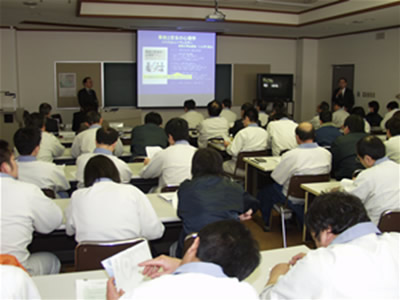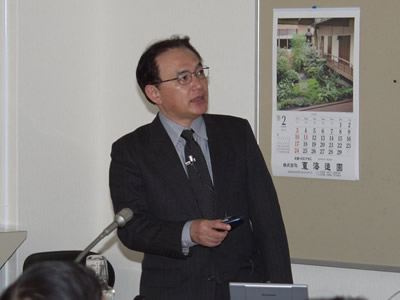
|
|
During the Safety Presentation
|
Approximately 60 employees of JGC Corporation and contractors' staff attended.
The presentation began with opening remark from Mr. Mamoru Numata, Manager of Technologies Research Center, JGC Corporation.
"Nuclear Energy is a very important source of electric power in Japan, but due to a series of recent scandals and troubles, public confidence has deteriorated. Japan Nuclear Technology Institute is working toward raising awareness and promoting safety culture, and carrying out activities with the objective of restoring confidence in nuclear power. The Safety Caravan is one such activity, which aims to raise safety awareness through lectures on safety and exchanging information on safety related matters, and today's Safety Caravan is being held here at the JGC Technologies Research Center.
"The JGC Technologies Research Center deals not only with nuclear energy, but also with a very wide range of research and development, ranging from oil and gas to biomass, and even technology development for use at chemical plants and the like, and so today we shall be presented with a talk that should prove useful to everyone on the topic of human errors.
"Today, Professor Matsuo of the University of Kitakyushu will present a talk entitled "Human Error and Safety Culture." It is certain that the talk will provide us all with insights that will be useful in our daily activities, so let us all listen intently."
After the opening remarks, Takashi Matsuo, Professor, Faculty of Humanities, University of Kitakyushu gave a presentation titled "Human Error and Safety Culture." |

|
|
Mr.Takashi Matsuo, Professor,
Faculty of Humanities, University of Kitakyushu
|
At the presentation, Professor Matsuo brought up some very valuable points, including the following.
○ Why do human errors occur?
The human animal lives by adapting to the real world. Looking back at the history of evolution, the human did not live in an environment where detailed accuracy was required, and therefore efficiency took priority over accuracy, and so it is no wonder that we are incapable of accurate and logical conduct and decisions. Accordingly, making errors (human errors) is part of the basic nature of the human being. Human errors posing problems consist of: 1) humans have come to operate large-scale energy-consuming equipment and machinery; and 2) due to division of duties, the communicating of information has become less reliable. In other words, this is not a problem of the individual person, but rather it is one of the structure and implements for communicating information.
○ Countermeasures for preventing human errors
In order to prevent human errors, we would have to eliminate the applicable work and make it difficult for errors to occur. However, there are limits to how far the human being can be reformed, and therefore there has got to be a fool proof design. In the event of errors occurring, it has got to be possible to detect the error, and hold the damages down to the smallest possible level. In the detection of errors, it is important to create a structure of clues from the outside, and as external clues, we can consider the six factors of target, indicator, context, document, electronic assistant, humans. Even if errors are discovered, however, unless a culture and system has been created for identifying, correcting, and recovering from errors, the error will remain as a team error, and will not lead to accident prevention. For the individual, raising skill level, boosting risk perception, and increasing specialist expertise are necessary, but beyond that, it is also important to share what needs to be understood in order to achieve safety culture.
○ Safety culture
Endeavors by the organization on the whole are needed in order to establish a safety culture. Individual conduct is dependent on the interests of the individual, and safe conduct is viewed as entailing a cost, and therefore individual conduct is not conducive to safe conduct. Rules are created by the organization, but there are exceptions to the rules, but when adhering to the rules results in having a cost, it becomes the norm to disregard the rules. In order to create a safe system, we must not cover up accidents, and must not punish the persons responsible for the accident, but instead we must establish a "learning culture" where we learn from accidents and near misses. Do not try to solve problems by punishing or dismissing the parties responsible, rather, clarify the causes of the accident, aim to prevent accidents, and make use of the accident in future case studies. To the contrary, exempt the parties from responsibility for the accident, investigate the causes of the accident, and tie this in to the benefit of the general public in order to prevent future accidents which might happen in which there would be many victims.
Comments from the questionnaires conducted after the presentation:
●Today's lecture was based on the idea that "to err is human" and this is an important endeavor toward safety, which is quite a different approach to creating a system in which errors cannot occur, and this idea is valuable information for future reference. I think it cannot be helped that concrete countermeasures are various and multi-faceted, but I also strongly believe that it is necessary to promote development by correlating endeavors with the Research Center. Thank you for the lecture.
●This was very good timing, as I am currently in the midst of endeavors to raise the level of safety awareness among the laboratory staff.
●Concrete examples were plentiful, and it was very easy to understand. Especially, I understood quite clearly why "it is not possible to eliminate human errors completely" as the professor mentioned at the beginning of the lecture, and so the information that followed was easy to digest. All of the topics mentioned were very informative. Also, the last part about "safety culture," I intend to keep this in mind as I do my job. I have heard similar things said in the past, but this is the first time it has been so firmly embedded in my consciousness. This has been a most worthwhile lecture.
● Just by seeing the title "making errors is part of the basic nature of the human being," the fog has lifted on a point that had been fuzzy up until now. Taking these words to heart, I believe I can feel more forgiving toward mistakes of others. I appreciate the several significant key words.
Afterward, Mr. Hamada, Planning Group Leader, of NSnet Division Japan Nuclear Technology Institute presented an overview of the activities of our organization.
|







